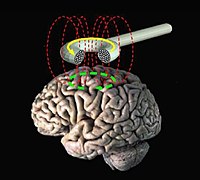
Photo from wikipedia
Leveraging preclinical knowledge regarding the role of hippocampal theta burst stimulation in learning and memory, in 2005 Huang and colleagues were the first to apply an intermittent bursting form of… Click to show full abstract
Leveraging preclinical knowledge regarding the role of hippocampal theta burst stimulation in learning and memory, in 2005 Huang and colleagues were the first to apply an intermittent bursting form of transcranial magnetic stimulation (theta burst stimulation, iTBS) to the human cortex [1]. Intermittent TBS increased cortical excitability in a manner that was more temporally efficient than non-bursting stimulation protocols. This manuscript has now been cited more than 3100 times and TBS may now be the dominant stimulation protocol of interest in the TMS field. It is currently used as a research tool and as a clinical treatment protocol for depression. While the translational relevance and temporal efficiency of TBS are powerful, there are many unanswered questions regarding the inter-individual variability in response to TBS. There have been numerous studies demonstrating a high degree of within- and between-subject variance in changes in cortical excitability following a single session of iTBS [2,3,4]. While the brain stimulation field has begun to look deeper into biological factors that may explain response variability in humans, there is growing concern that, on a fundamental level, iTBS may not be a reliable tool to increase cortical excitability. This study was designed to address this gap in our knowledge through a nonhuman primate model. Nonhuman primates provide a complementary experimental system with neuroanatomical similarity to humans, yet amenable to more controlled experimental designs. Using a cohort of 6 animals, we recently demonstrated that it is possible to collect motor evoked potentials and recruitment curves with high test-retest reliability using standard figure-of-8 coils in sedated NHPs
Journal Title: Brain Stimulation
Year Published: 2022
Link to full text (if available)
Share on Social Media: Sign Up to like & get
recommendations!